Welcome to the second article in our three-part guide for doing yoga classes in Japanese!
In the previous article, I mentioned that when I decided to take yoga lessons in Japan I didn't think I'd have any trouble understanding the instructions because I knew all the parts of the body in Japanese. If you read it, you will know that is not true, I did not know all the parts of the body, and I was a complete numbskull. This is because there are many more parts of the body than just your basic 頭, 肩, ひざ, and 足. In fact, there are many words I did not know for incredibly specific parts of the body, like the names of individual bones, of which the human body famously has quite a few.
These are all lists I wish I could have had back when I started taking yoga classes in Japan!
So in this article I'll help you get a leg up and avoid yoga-related numbskullery by going through both the basic — and not so basic — words for the parts of the body you might hear in a Japanese yoga class. We'll also go through vocabulary for directions, related prefixes and suffixes, positions, and common yoga poses. Lastly, we'll review a few particles that are often used in combination with these words. These are all lists I wish I could have had back when I started taking yoga classes in Japan!
Now, you may be thinking, that's a lot of vocab. And you're right, it is — but please don't think that you need to have everything memorized before you even try doing a yoga class. There's no need to numb your skull cramming vocab. Instead, I suggest a strategic approach.
Start first by looking through the lists and getting a sense for the type of words you'll hear. Then, go ahead and try doing a class. I recommend starting with an online video, even if you want to eventually take classes in person. You'll likely hear words that you're not familiar with; if that happens, you can come back to this article and use it as a reference, either during the class if necessary, or afterwards as a review. As I mentioned in the first article, trying to remember new vocab while trying not to topple over in crow pose is fairly difficult, and trying later to look up those words with a decidedly not-fresh memory is, dare I say, nigh impossible, so I hope these lists will help you avoid that type of situation.
Now, onto the vocab!
- Parts of the Body
- Directions
- Prefixes and Suffixes
- Positions
- Basic Yoga Poses
- Particles Commonly Used in Japanese Yoga Classes
- Take 5: Five Pocket Words for Ready Reference
Prerequisites: This article assumes you already know hiragana and katakana. If you need to brush up, have a look at our Ultimate Hiragana Guide and Ultimate Katakana Guide.
Parts of the Body
Let's start with the main subject of this article — body parts! These lists do include basic parts of the body, so some (or many) of these words may already be familiar to you, but never fear! There are probably a few unfamiliar ones you can learn today as well. We'll go from head to toe, then move onto the advanced vocabulary with those more elusive bones and joints.
Above the Neck
You may have seen most words here in this list because they are pretty basic. However, textbooks typically don't include おでこ (forehead) and あご (chin), which are frequently used in yoga classes.
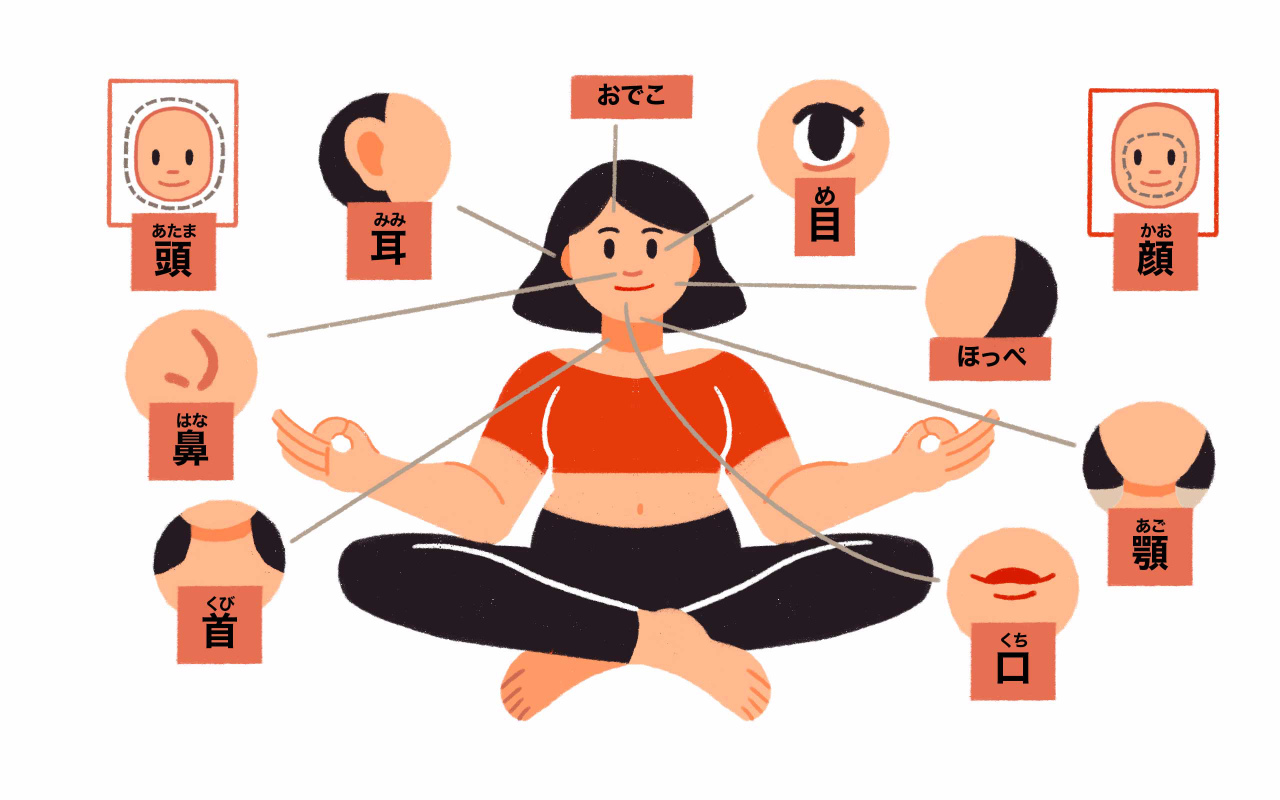
| 頭 | あたま | head |
| 顔 | かお | face |
| 額 おでこ |
ひたい | forehead |
| 目 | め | eye |
| 視線 | しせん | line of sight |
| 鼻 | はな | nose |
| 耳 | みみ | ear |
| 頬 ほっぺ ほっぺた |
ほお | cheek |
| 口 | くち | mouth |
| 顎 | あご | chin |
| 首 | くび | neck |
Upper Body
Many of these words may also be familiar, but one I'll take care to point out in particular is 上体 (upper body). Written out, its meaning is pretty obvious, but as I said in the previous article, it was a deceptively difficult word to understand in classes because I kept confusing it with its pesky homonym friend 状態 (condition).
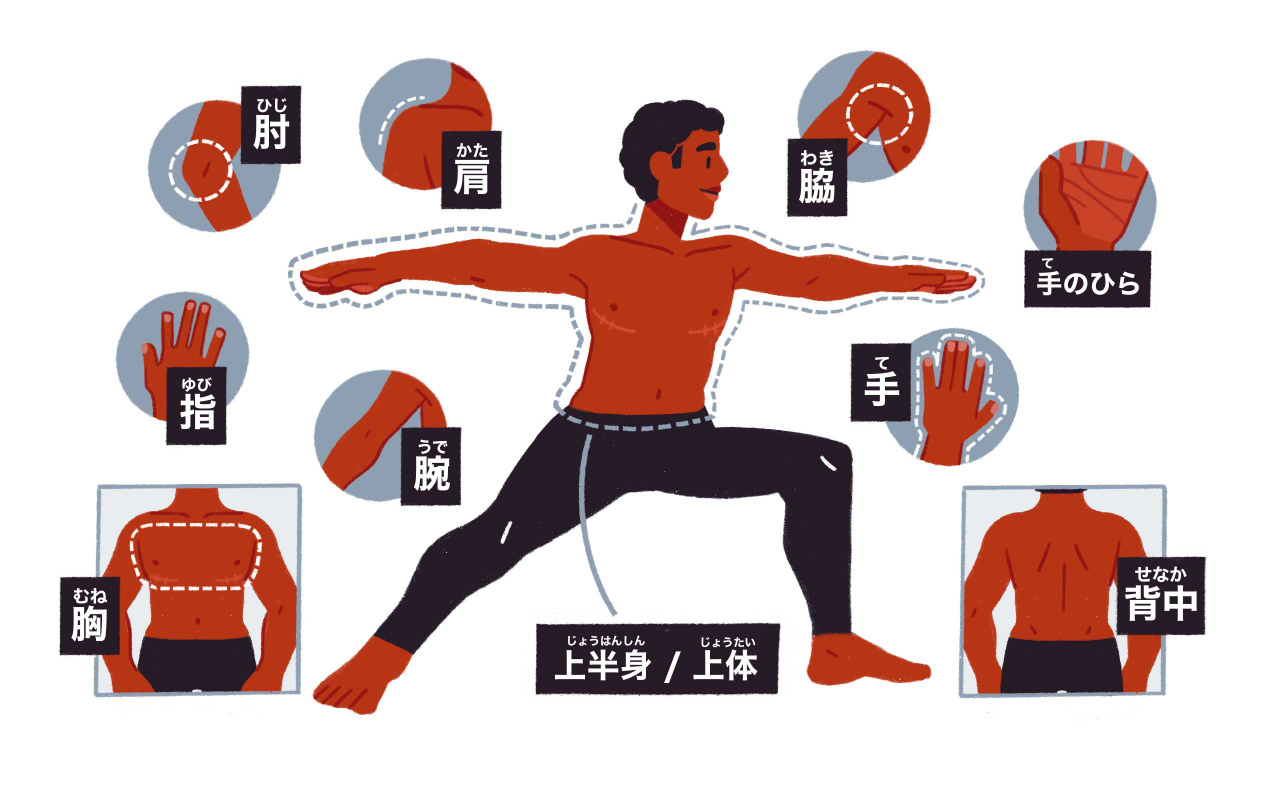
| 上半身 / 上体 | じょうはんしん / じょうたい | upper body |
| 肩 | かた | shoulder |
| 脇 | わき | armpit |
| 腕 | うで | arm |
| 肘 | ひじ | elbow |
| 手 | て | hand |
| 手のひら | てのひら | palm of one's hand |
| 指 | ゆび | finger |
| 胸 | むね | chest |
| 背中 | せなか | back |
Lower Body
Again, you'll likely know many of the words on this list, but I was surprised to realize I hadn't learned the words for thigh (太もも), calf (ふくらはぎ), or shin (すね) before my yoga classes.
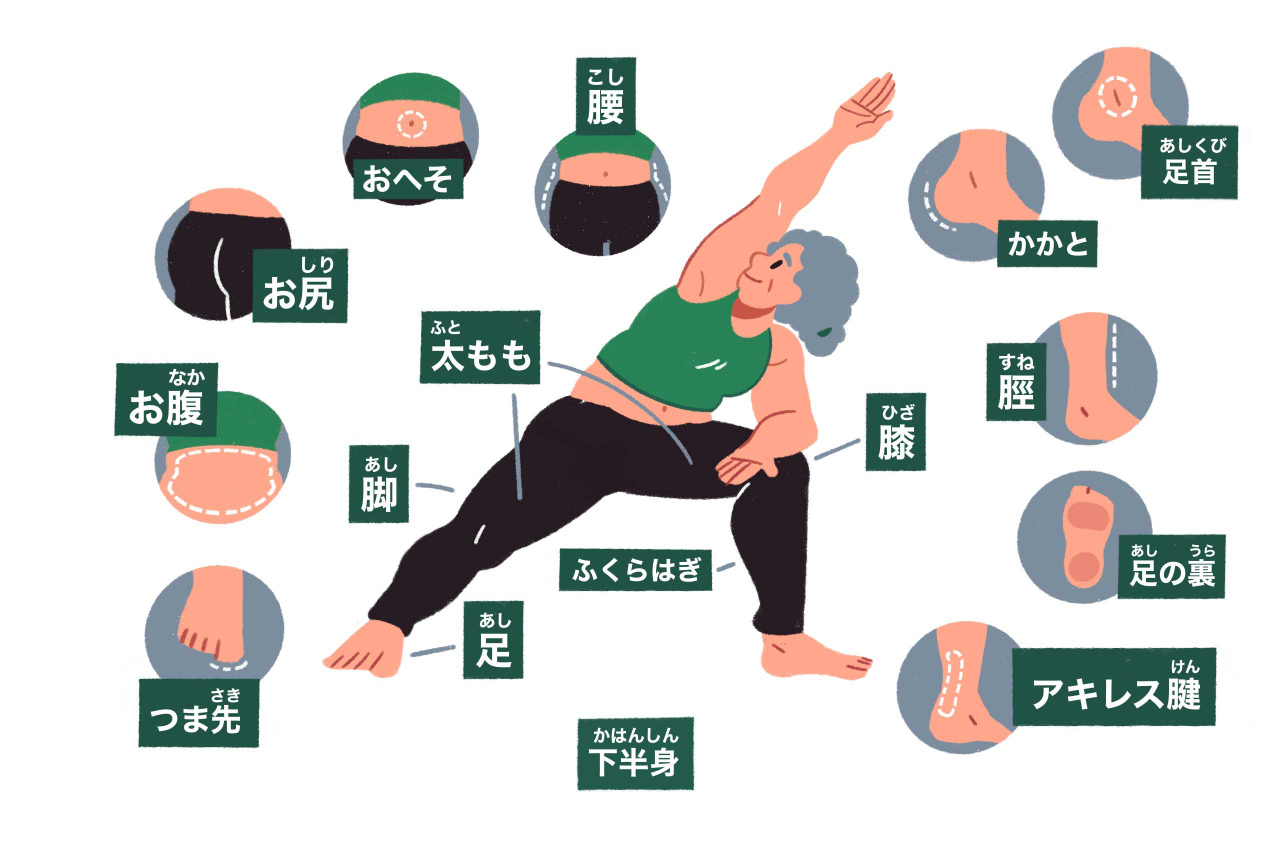
| 下半身 | かはんしん | lower body |
| お腹 | おなか | abdomen, stomach |
| おへそ | bellybutton | |
| 腰 | こし | hips, lower back, waist |
| お尻 | おしり | bottom, butt |
| 脚 | あし | leg |
| 太もも | ふともも | thigh |
| 膝 | ひざ | knee |
| ふくらはぎ | ふくらはぎ | calf |
| 脛 | すね | shin, lower leg |
| 足 | あし | foot |
| 足首 | あしくび | ankle |
| 足の裏 | あしのうら | bottom of the foot, sole |
| つま先 | つまさき | toe, tip of toe |
| かかと | かかと | heel of foot |
| アキレス腱 | あきれすけん | Achilles tendon |
Bones, Joints and Other Advanced Vocabulary
Okay, now we're ready to enter more technical territory, but please don't fret — there's no need to memorize all these words at once. Keep this list to use as a reference and use it to review after your yoga class. Many of these words come up pretty frequently in yoga lessons, so you may find that you'll start to remember the words organically without even practicing.
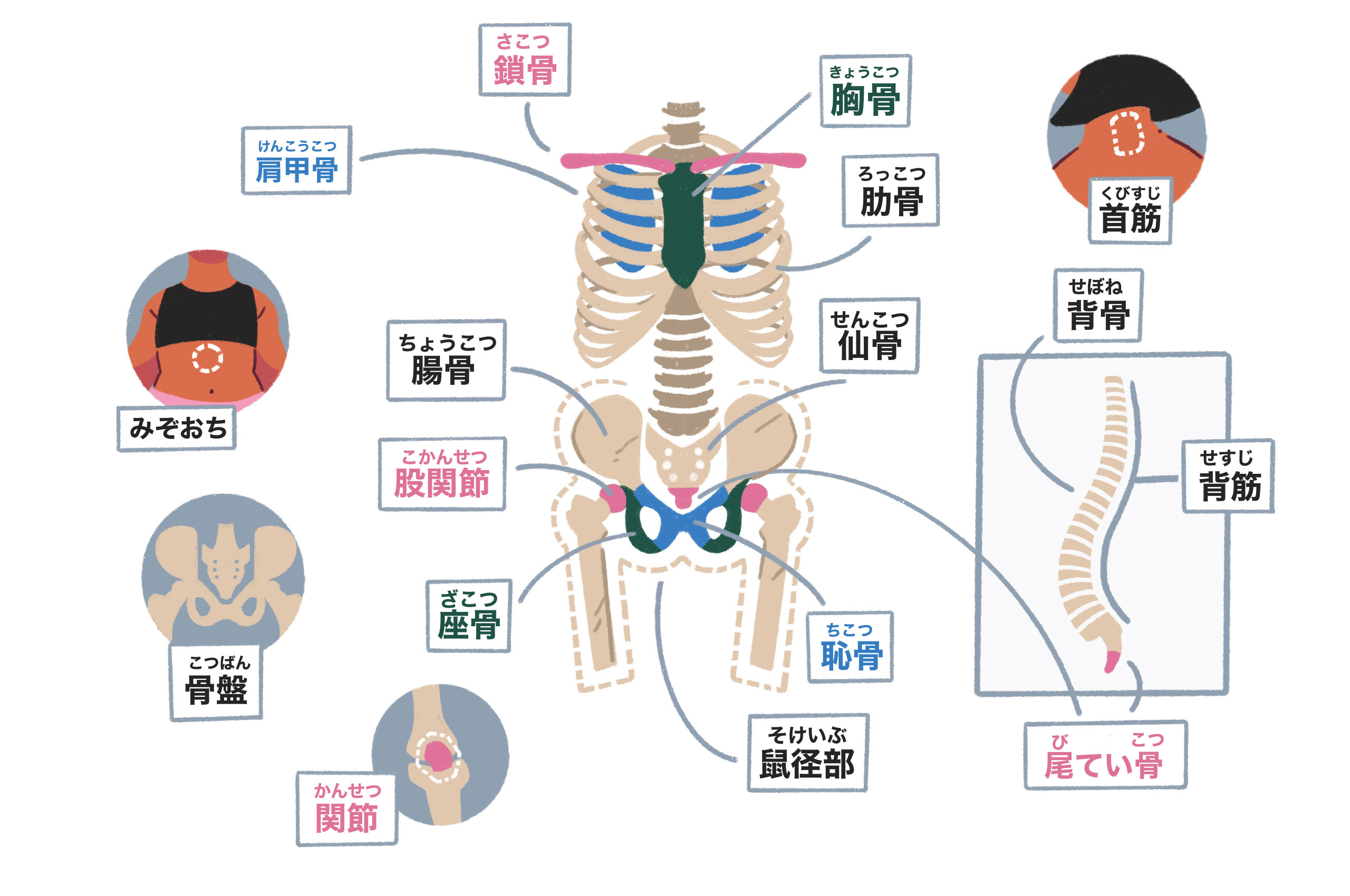
| 首筋 | くびすじ | nape of the neck, back of the neck |
| 鎖骨 | さこつ | clavicle, collarbone |
| 肩甲骨 | けんこうこつ | scapula, shoulder blade |
| 胸骨 | きょうこつ | sternum, breastbone |
| 背骨 | せぼね | spine, backbone |
| 背筋 | せすじ | spine, line of the backbone |
| 肋骨 | ろっこつ | rib |
| みぞおち | pit of the stomach, solar plexus | |
| 鼠径部 | そけいぶ | groin |
| 股関節 | こかんせつ | hip joint |
| 骨盤 | こつばん | pelvis |
| 恥骨 | ちこつ | pubis |
| 仙骨 | せんこつ | sacrum |
| 座骨 | ざこつ | ischium (part of pelvis) |
| 腸骨 | ちょうこつ | ilium (part of pelvis) |
| 尾骨 / 尾てい骨 | びこつ / びていこつ | coccyx, tail bone |
| 関節 | かんせつ | joint |
Directions
Now that we have the body covered, let's look at words that tell you where to move those body parts: directions! You might be familiar with many of the words here from your Japanese textbooks, but there are other ways of saying basic words like 前 (forward), 後ろ (behind), and 上 (above) that you might not have encountered. For example, 前方 is used almost interchangeably with 前, but it's not as commonly taught in typical textbooks.
| 前 / 前方 | まえ / ぜんぽう | front, or forward |
| 後ろ / 後方 | うしろ / こうほう | behind |
| 〜の方 | 〜のほう | direction of 〜 |
| 横 | よこ | side |
| 右 | みぎ | right |
| 左 | ひだり | left |
| 左右 | さゆう | left and right |
| 中心 | ちゅうしん | center |
| 両方 | りょうほう | both sides |
| 反対 | はんたい | opposite side |
| 外側 | そとがわ | outside |
| 内側 | うちがわ | inside |
This next list is also related to directions, but focused specifically on the many ways to indicate "above" and "below." You sometimes hear yoga teachers using words like the "sky" and "ground" to mean "above" and "below" in English yoga lessons, right? It's the same in Japanese yoga classes, too.
| 上 | うえ | above |
| 天井 | てんじょう | ceiling |
| 太陽 | たいよう | sun |
| 空 | そら | sky |
| 頭上 | ずじょう | above head |
| 下 | した | below |
| マット | まっと | mat |
| 床 | ゆか | floor |
| 大地 | だいち | ground |
Prefixes and Suffixes
Now let's look at prefixes and suffixes. You may remember from English class that a prefix is a linguistic element that is placed at the beginning of a word to change its meaning. For example, "uni-" is an English prefix that means "one," as in "I saw a unicorn riding a unicycle." With a suffix, the element is placed at the end of the word.
Certain prefixes and suffixes get paired up with words for body parts or directions, and you'll often hear them in Japanese yoga lessons.
| Prefix/Suffix | Reading | Meaning | Example (Translation) |
|---|---|---|---|
| 〜幅 | 〜はば | width of … | 肩幅 (shoulder width) |
| 〜側 | 〜がわ | … side | 右側 (right side) |
| 〜先 | 〜さき | tip of … | 指先 (fingertips) |
| 〜度 | 〜ど | … degree | 90度 (ninety degree) |
| 両〜 | りょう〜 | both … | 両手 (both hands) |
| 真〜 | ま〜 | right … | 真上 (right above) |
Positions
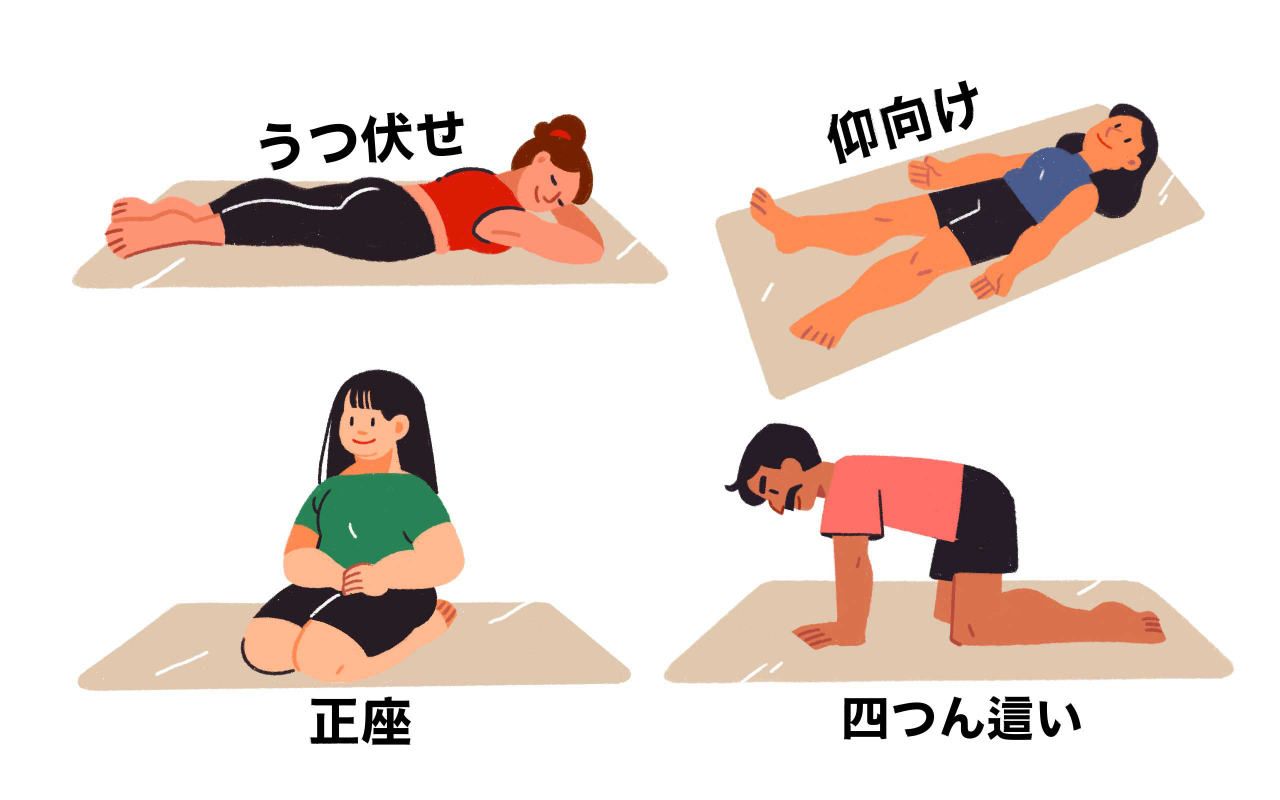
Before we get to formal yoga poses, there are terms for a few common body positions that instructors will often use interchangeably with the name for the pose in yoga, or when explaining how to do a more complicated yoga pose. For example, teachers may use 仰向け (lying face-up) to as a shorthand for corpse pose, or say to move into 四つん這い (getting on one's hands and knees) before explaining what to do next.
| うつ伏せ | うつぶせ | lying face-down |
| 仰向け | あおむけ | lying face-up |
| 正座 | せいざ | sitting on the knees |
| 合掌 | がっしょう | putting palms together |
| 四つん這い | よつんばい | getting on one's hands and knees, getting down on all fours |
Basic Yoga Poses
Now let's look at names for some common yoga poses. Of course there are many more poses than I've covered here, but this list will take you pretty far. I've mainly included the Japanese versions of the poses, but please note that depending on your instructor or yoga studio, you may hear the Sanskrit or English terms used instead.
| 仰向けの合蹠のポーズ | あおむけのがっせきのぽーず | reclining bound angle pose |
| 仰向けのねじりのポーズ | あおむけのねじりのぽーず | reclining spinal twist |
| 椅子のポーズ | いすのぽーず | chair pose |
| 板のポーズ | いたのぽーず | high plank pose |
| 上向きの犬のポーズ アップドッグ |
うえむきのいぬのぽーず あっぷどっぐ |
upward facing dog pose |
| 英雄のポーズ1 戦士のポーズ1 |
えいゆうのぽーずいち せんしのぽーずいち |
warrior I pose |
| 開脚の前屈のポーズ | かいきゃくのぜんくつのぽーず | wide-legged forward bend |
| 合蹠のポーズ | がっせきのぽーず | bound angle pose, cobbler's pose |
| 木のポーズ | きのぽーず | tree pose |
| 子供のポーズ | こどものぽーず | child's pose |
| コブラのポーズ | こぶらのぽーず | cobra pose |
| 三角のポーズ | さんかくのぽーず | triangle pose |
| 屍のポーズ | しかばねのぽーず | corpse pose |
| 四肢のポーズ | ししのぽーず | low plank pose |
| 下向きの犬のポーズ ダウンドッグ |
したむきのいぬのぽーず だうんどっぐ |
downward facing dog pose |
| 戦闘をやめた英雄のポーズ 平和な戦士のポーズ |
せんとうをやめたえいゆうのぽーず へいわなせんしのぽーず |
reverse warrior pose |
| 体側を伸ばすポーズ | たいそくをのばすぽーず | extended side angle pose |
| 杖のポーズ | えだのぽーず | staff pose |
| トカゲのポーズ | とかげのぽーず | lizard pose |
| 猫のポーズ | ねこのぽーず | cat pose (or cat and cow pose) |
| 牛のポーズ | うしのぽーず | cow pose |
| ねじった三角のポーズ | ねじったさんかくのぽーず | revolved triangle pose |
| ハイランジ | はいらんじ | high lunge |
| ハッピーベイビーのポーズ | はっぴーべいびーのぽーず | happy baby pose |
| 花輪のポーズ | はなわのぽーず | yogi squat |
| 針の糸通しのポーズ | はりのいととおしのぽーず | thread the needle pose |
| 舟のポーズ | ふねのぽーず | boat pose |
| 三日月のポーズ | みかづきのぽーず | crescent moon pose |
| 山のポーズ | やまのぽーず | mountain pose |
| 弓のポーズ | ゆみのぽーず | bow pose |
| 立位前屈 | りついぜんくつ | standing forward bend |
| 鷲のポーズ | わしのぽーず | eagle pose |
Particles Commonly Used in Japanese Yoga Classes
Lastly, I'd like to introduce a few particles that often get paired with the words we've just learned. These are pretty basic particles though, so feel free to skip this section if you already feel like you've got the hang of を, に, and から.
Particle を
The particle を marks the direct object in a sentence. The direct object is the thing that is acted on or affected by the verb. For example, if your yoga teacher says, "Next, we'll circle our shoulders," "we" is the subject (the people/thing doing the action, in this case the circling), "will circle" is the verb (the action the subject — we — will do), and "shoulders" is the direct object (the thing that receives the action — or what is being circled). So, in a Japanese yoga class your teacher would say:
- 肩を 回します。
- Next, (we)'ll circle our shoulders.
In English, we don't mark the direct object in any special way, but in Japanese the direct object is immediately followed by the particle を. So looking at our example sentence, we know that 肩 (shoulder) is the direct object because it is followed by を. (And I'll quickly remind you here that, as in the sentence above, subjects often get dropped in Japanese sentences — for more on that, see Particle が (Subject): Subject Omission.) Since the very nature of yoga classes involves doing some verb-action with a body part/direct object, you'll hear を quite often.
Particle に
Yoga teachers use the particle に in a few different ways. One of the common uses is marking the specific direction or location where your body part should be, or will be. For example, if your yoga teacher says to tilt your body, they would use に to mark the direction you should be tilting your body towards.
- 体を左側に 傾けて…
- Tilt your body to the left side…
The particle に can also be used to indicate the result of a transformation. Yoga instructors will often use this version of に when they tell you to transition to a new pose or position. In the following sentence, 仰向け (lying face-up) is marked by に, so に indicates that 仰向け will be the result of the transformation, or in other words, the position to move into.
- 仰向けになります。
- Lay down face-up.
(Literally: Turn yourself into the laying-down-face-up position.)
Another time you may hear the particle に in yoga classes is when it is used to turn な-adjectives into adverbs. For example, 水平 is a な-adjective meaning "level" or "horizontal." When followed by に, it becomes an adverb.
- 右足を床と水平に 持ち 上げて…
- Lift your right foot [so that it's] level with the floor…
Particle から
Particle から is similar to the English preposition "from," and it marks a beginning point. In yoga classes, to say things like "exhale from the mouth," から gets used.
- 口から 息を 吐きます。1
- Exhale from the mouth.
Take 5: Five Pocket Words for Ready Reference
Whew! Now, we've just covered a lot of words, but as I said before, there's no need for you to get overanxious and try to learn all this vocab before you try your first lesson. In fact, please do not do that! One of the joys of learning Japanese by doing another activity is that there's lots of opportunities to learn vocabulary organically. However, it certainly doesn't hurt to learn a few words before you start, or keep a short list of words in your pocket — and so I present Pocket Words! These are five words from this article that I think would be most helpful to know before starting. They're words that you may be unfamiliar with, but they come up all the time in yoga classes. Warm up by practicing these five words, or just put ‘em in your pocket!
| 視線 | しせん | line of sight |
| 背筋 | せすじ | spine, line of the backbone |
| 股関節 | こかんせつ | hip joint |
| 骨盤 | こつばん | pelvis |
| 仰向け | あおむけ | lying face-up |
I'll see you in the next article in our series, Japanese Vocabulary for Yoga: Movements, where we'll move mountains to go through vocabulary for movements. Onward and upward!
-
Unlike in English, where we say "Inhale through the nose," in Japanese, から is actually used for inhaling as well. For example, 鼻から息を吸います。 ↩
